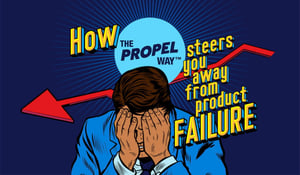A lot of time, cost and effort goes into bringing a new product to market. In many cases, the launch of a product can make or break an entire business. There’s a tendency for many stakeholders to tune out negativity so they can cultivate a winning attitude within organisations. But closing your ears to any unwelcome input risks cognitive dissonance, turning into a situation where no one wants to voice concerns for fear of upsetting the apple cart.
It's no surprise when environments like this fail to launch a winning product. To gain insights about the path to success, it’s important to deeply understand why products fail and the factors that lead to product failure.
Why do products fail?
It’s difficult to nail down every type of product failure in one article, given the vast range of factors that can contribute to an unsuccessful launch. However, we can define several broad categories of failure that these product launches generally fall into.
Poor execution leading to a failure to meet the customer’s needs
Even a good product idea can fail if its execution misses the mark. In practice, that means that the need for the product or problem exists, but the solution is either poorly designed or poorly built. Generally this is a product that hasn’t been tested with users throughout the development process, and fails to address real-world user needs. In other words, when expectations for the product don’t match the reality of the user. Potential customers who have a legitimate need may even check out the product, but still decide there’s not a compelling enough reason to change from an existing solution.
Technology looking for a problem
Many products are influenced (or in some cases, blinded) by a “data point of one”—an influential leader whose own opinions and ideas guide development without user testing or validating with the market. The HIPPO (Highest Paid Person's Opinion) in the room is a very real phenomenon, and can easily lead down the path to failure. For example, a well-meaning but misguided VP may become enamoured with a particular technology, and are now looking for a problem to solve with it. It’s remarkably common for even experienced, mature companies to get excited about a technology and then try to carve out a market for it, while struggling to find a real customer need.
Poor company fit
In this case, there may be a real customer need to address, but the solution is not a good fit for the company’s strategy, its positioning or its area of expertise. That means the product will not get the priority or long-term support it needs to make it a success either during development or at the go-to-market stage.
Ineffective marketing
‘Build it and they will come’. If only that was true in the world of product development. It’s a highly competitive market out there, which means your product needs to stand out and make waves in the right crowd to get any traction. You can have the most effective and well-designed product in the world, but if no one has heard of it, it’s not likely to succeed. Many companies underestimate the sheer amount of time, resources and effort it takes to reach audiences in a crowded market.
Tactical instead of a strategic approach
Short-termism has led to the premature death of countless products. A short-term, non-strategic mindset encourages a scattergun approach, leading to managers throwing a series of product ideas at the wall to see what sticks, with no real intent to commit to further developing any specific one unless they find success by chance. Not only does this line of thinking cripple the chances of product success, but it’s also a huge blow to a company’s reputation. Any trust that the company can effectively deliver and support products is all but eroded by abandoned product lines.
A successful strategy helps avoid failure
A well-thought-out plan that factors in immediate, mid-term and long-term goals serves as a great compass for product development. Strategising at every step minimises the small risks that accumulate along the way such as time and cost blowouts. It also offsets the chance of overall product failure by ensuring key benchmarks of user acceptance and market-fit are met consistently along the development pipeline, informing and guiding it with time to course-correct.
We often assess need by looking at the gap between the importance of the customer’s job to be done and their satisfaction with the current solution. If the job is important and satisfaction is low with the current solution, then there is an opportunity to strike gold. A solid product development strategy should align to the business strategy, solving a valuable and validated customer need where there is a big enough opportunity to make the investment worthwhile.
The ROI of strategic product development
A strategic partner helps design the qualities that are critical to product success into the development process itself. They can steer efforts from a higher level vantage point, drawing from a wealth of experience launching similar products. As specialists, they have rich experience of what works and what doesn’t, and can foresee and pre-empt the countless number of traps, risks and assumptions inherent in any product development initiative.
Strategy alone is not sufficient though. The need to execute well is paramount, and the key to turning a great blueprint into a successful product. Execution encompasses iteration, learning, and closing the feedback loop to ensure that the product strategy continues to align with user insights. Product leaders must be involved and across everything needed to evolve product design and strategy along the way. A strategic partner doesn’t only help to create the strategy, but ensures its successful execution too.
Talk to us about how to build a more effective product strategy, and how we can work together to steer your development process away from common pitfalls and toward success.

